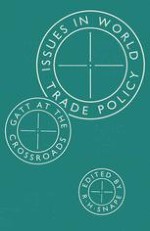1986 | OriginalPaper | Buchkapitel
Why Have US Tariffs Fallen Since 1930?
verfasst von : J. J. Pincus
Erschienen in: Issues in World Trade Policy
Verlag: Palgrave Macmillan UK
Enthalten in: Professional Book Archive
Aktivieren Sie unsere intelligente Suche, um passende Fachinhalte oder Patente zu finden.
Wählen Sie Textabschnitte aus um mit Künstlicher Intelligenz passenden Patente zu finden. powered by
Markieren Sie Textabschnitte, um KI-gestützt weitere passende Inhalte zu finden. powered by
The most striking feature of American tariff history has been the contrast between the growth of tariff protection to nearly prohibitive levels in 1934, and the decline since that year to an almost negligible figure. This contrast is all the more remarkable because, up to the early 1930s, it was ‘a commonplace that tariff legislation of the United States has been a paradise of pressure groups’ (Chamberlain, 1946, p. 85); ‘The history of the American tariff records the triumph of special interests over the general welfare’ (Tasca, 1938, p. 1). Every student of American politics then knew why the tariff was high and, more important, knew why it would continue to be high. In his brilliant study of the 1929/30 Hawley-Smoot Act — the study was completed after the passage of the 1934 Reciprocal Trade Act — Schattschneider judged that tariff policy ‘has been firmly established in the. public favour. It seems to have been stabilized, and nearly all important opposition has, for the time being, disappeared’. The tariff policy was ‘a great political success’, and was ‘politically invincible’ (Schattschneider, 1935, p. 282). The tariff, to 1934 at least, revealed the true nature of American democracy — its domination by interest groups — in a way that was remarkable only for the transparency of the redistributive means used.
